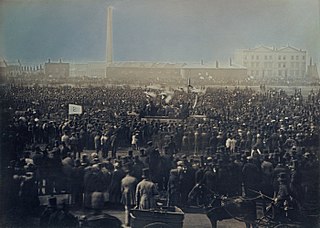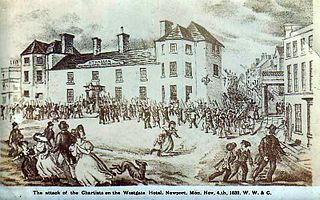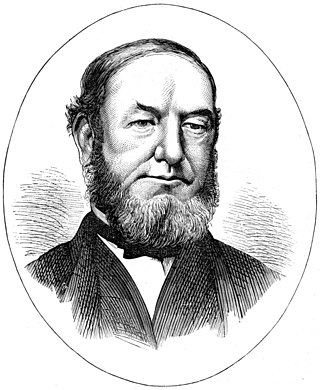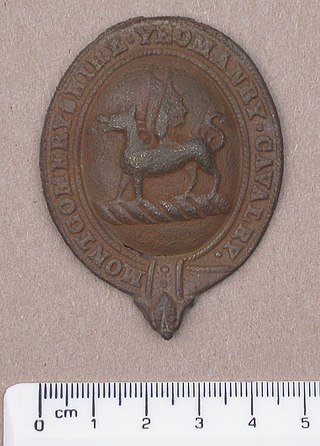Related Research Articles

Chartism was a working-class movement for political reform in the United Kingdom that erupted from 1838 to 1857 and was strongest in 1839, 1842 and 1848. It took its name from the People's Charter of 1838 and was a national protest movement, with particular strongholds of support in Northern England, the East Midlands, the Staffordshire Potteries, the Black Country and the South Wales Valleys, where working people depended on single industries and were subject to wild swings in economic activity. Chartism was less strong in places, such as Bristol, that had more diversified economies. The movement was fiercely opposed by government authorities, who finally suppressed it.

John Frost was a prominent leader of the British Chartist movement in the Newport Rising.

Powys is a county and preserved county in Wales. It borders Gwynedd, Denbighshire, and Wrexham to the north; the English ceremonial counties of Shropshire and Herefordshire to the east; Monmouthshire, Blaenau Gwent, Merthyr Tydfil, Caerphilly, Rhondda Cynon Taf, and Neath Port Talbot to the south; and Carmarthenshire and Ceredigion to the west. The largest settlement is Newtown, and the administrative centre is Llandrindod Wells.

Zephaniah Williams was a Welsh coal miner and Chartist campaigner, who was one of the leaders of the Newport Rising of 1839. Found guilty of high treason, he was condemned to death, but his sentence was commuted to life imprisonment in Tasmania. Eventually he was pardoned, and his discovery of coal on that island earned him a fortune.

Llanidloes is a town and community on the A470 and B4518 roads in Powys, within the historic county boundaries of Montgomeryshire, Wales. The population in 2011 was 2,929, of whom 15% could speak Welsh. It is the third largest settlement in Montgomeryshire, after Newtown and Welshpool.

South Wales is a loosely defined region of Wales bordered by England to the east and mid Wales to the north. Generally considered to include the historic counties of Glamorgan and Monmouthshire, south Wales extends westwards to include Carmarthenshire and Pembrokeshire. In the western extent, from Swansea westwards, local people would probably recognise that they lived in both south Wales and west Wales. The Brecon Beacons National Park covers about a third of south Wales, containing Pen y Fan, the highest British mountain south of Cadair Idris in Snowdonia.

The Newport Rising was the last large-scale armed rising in Wales, by Chartists whose demands included democracy and the right to vote with a secret ballot. On Monday 4 November 1839, approximately 4,000 Chartist sympathisers, under the leadership of John Frost, marched on the town of Newport, Monmouthshire. En route, some Newport chartists were arrested by police and held prisoner at the Westgate Hotel in central Newport. Chartists from industrial towns outside of Newport, including many coal-miners, some with home-made arms, were intent on liberating their fellow Chartists. Fighting began, and soldiers of the 45th Regiment of Foot, deployed in the protection of the police, were ordered to open fire. About 10-24 Chartists were confirmed killed, whilst reports of perhaps a further 50 injured. 4 soldiers were reported as injured, as well as the mayor of Newport who was within the hotel. Subsequently, the leaders of the rising were convicted of treason and were sentenced to be hanged, drawn and quartered. The sentence was later commuted to transportation.

William Lovett was a British activist and leader of the Chartist political movement. He was one of the leading London-based artisan radicals of his generation.
The Welsh Oak is a pub located in Pontymister, Caerphilly County Borough, Wales. In recent years, due to a decline in trade, the pub has ceased trading.
This article is about the particular significance of the year 1839 to Wales and its people.

William Jones (1809–1873) was a political Radical and Chartist, who was a former actor, working as a watchmaker at Pontypool in Monmouthshire and also kept a beer house.
Nantyglo is a village in the ancient parish of Aberystruth and county of Monmouth situated deep within the South Wales Valleys between Blaina and Brynmawr in the county borough of Blaenau Gwent.
The Llanidloes and Newtown Railway (L&NR) was a railway company between Llanidloes and Newtown in Montgomeryshire, Wales. It was promoted locally when plans for trunk railways passing through the locality were cancelled; local people saw that a railway connection was essential to the flannel industry in the district. The 17-mile (27 km) line opened in 1859, and at first was isolated from any other railway, but from 1861 it became connected to Oswestry by an allied railway company, and other companies also connected to it. From 1864 the company was incorporated into the new Cambrian Railways company.

The Montgomeryshire Yeomanry was a Welsh auxiliary unit of the British Army first formed in 1803. It served in home defence and for internal security, including deployments to deal with Chartist disturbances in the 1830s. It provided volunteers to the Imperial Yeomanry during the Second Boer War and formed three regiments for service during World War I. It was broken up and converted to infantry and artillery in 1920.

Llanidloes Town Football Club are an association football club based in the town of Llanidloes, Wales. They currently play in the Cymru North.
Reginald James Blewitt (1799–1878) was a British MP. He built up the Monmouthshire Merlin newspaper and refurbished Llantarnam Abbey.

Sir Thomas Phillips was a Welsh lawyer, politician and businessman, who was Mayor of Newport in Monmouthshire at the time of the Newport Rising in 1839.
Thomas Prothero (1780–1853) was a Welsh lawyer, mine owner and businessman, known as an opponent of John Frost.

The woollen industry in Wales was at times the country's most important industry, though it often struggled to compete with the better-funded woollen mills in the north of England, and almost disappeared during the 20th century. There is continued demand for quality Welsh woollen products.
References
- 1 2 3 4 Williams, David (1939). John Frost: A study in Chartism. Cardiff: University of Wales Press Board. pp. 100, 104, 107.
- 1 2 3 4 5 Jones, David (1985). The Last Rising: The Newport Chartist Insurrection of 1839. Oxford: Oxford University Press.
- ↑ Wilks, Ivor (1984). South Wales and the Rising of 1839 . Coom Helm. pp. 12.
- ↑ Williams, Sian Rhiannon (2011). Gwent County History Volume 4, The Languages of Monmouthshire. University of Wales Press. pp. 156–157.
- ↑ Waycott, James and ap Hwyel, Ruth, Les and Elin (2011). Voices for the Vote: Shire Hall and the story of Chartism in south Wales. Shire Hall Monmouth. p. 20. ISBN 978-0-9568745-0-4.
{{cite book}}: CS1 maint: multiple names: authors list (link) - ↑ https://en.m.wikipedia.org/wiki/2019_United_Kingdom_general_election
- ↑ https://en.m.wikipedia.org/wiki/Blackwood,_Caerphilly#The_Chartist_Bridge